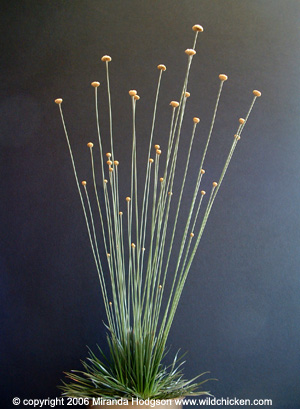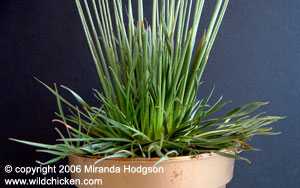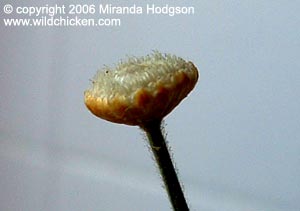





Syngonanthus chrysanthus 'Mikado' (also called 'Mikado')
Syngonanthus
chrysanthus
'Mikado'
An elegant and unusual new tender plant, which forms a rosette of foliage from which long straight stems grow, each bearing one, creamy-gold, pin-head flower. Very much an indoor plant in the UK, it could be tried in a warm bright bathroom where it will have the humidity and warmth it needs to thrive.
Syngonanthus chrysanthus ‘Mikado’ comes from the family of the Eriocaulaceae and is native to Brasil.
As this is a newly acquired plant, I've discovered what I can about it so far, and will add to the page as time and experience go on.
Summer, though may last longer under the right conditions.
Habit - forms an upright, straight-sided vase shape. H: 15cm, S: approx 8cm.
Stems - straight, leaning, pale green, slightly hairy. Up to 35cm long. From 15-50 stems per plant, depending on maturity.
Leaves - rosette-forming, at the base of the plant. Soft, narrow, lanceolate, mid-green leaves which look similar to grass.
Flowers - one creamy-gold, pin-head like flower borne at the tip of each stem. The flowers have a papery look to them. No scent is apparent. The flowers are reported to last for up to 10 weeks, and flowering can continue for up to 50 weeks.
Bright but indirect light. Needs humid surroundings.
Acid compost (pH of 4-5). Well drained but kept moist at all times.
Tender - best grown between 19-22°C.
Because of its origin as a swamp plant, humidity should be kept high, at around 70% if possible. Keeping the plant in a tall, straight sided glass vase, or a deep bowl, and spraying it regularly with filtered water will help to keep the humidity level up. Water regularly, from the bottom of the pot rather than from above, and don’t allow the compost to dry out. The best place for it would probably be a bright, warm bathroom, unless you can provide its exact requirements elsewhere.
May be susceptible to aphids. May be affected by fungal attack if humidity is too high.
The plant has had patents taken out on it and a licence is needed for propagation.
Information sources:
Dutch breeders - Anthura
Garden Plant Information list of plant care info by botanical name